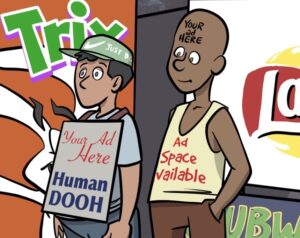Whether it’s on a shelf, Instacart or an online shopping page, a brand needs to take advantage of every inch it has to express itself and entertain potential customers.
At least that’s always been the perspective of Oatly, the Swedish oat milk brand known for self-deferential marketing. On billboards and its packaging, the company likes to grab attention and turn that attention into potential new customers.
“Everything started from the packaging and has grown from there,” Malia Killings, Oatly’s North America creative director and design director.
The company was motivated to rebrand its line of creamers this year partially because the new recyclable plastic bottles didn’t have the same canvas for the brand as the milk carton. “A large part of us redesigning the packaging was to make sure we could bring back the Oatly voice on those pack sides,” Killings said.
Defying the standardized approach
For many food and beverage brands carried on countless different store shelves, the API-based system of online grocery and advertising often leads to templated versions of product pages, keywords, product descriptions, imagery and the like.
For Oatly, there’s a commitment to making each bit of copy feel original, Killings said.
The product description on Kroger’s site might read, “You’re also on Kroger today! That’s so great. Nice to see you here,” she said. Those retailers allow only strict word counts in certain boxes on the page and want specific types and formats of image or video, she added. Plus they need to convey the actual product info.
Oatly’s copywriter is kept busy making sure even those little bits of brandable real estate are in an Oatly voice. “We think all of that can help grab attention,” Killings said.
“We try not to make our choices based on data-driven results of things,” she said. “We try and make our choices based on what feels like the right thing to do and what keeps our brand voice strong.”
Any generators?
If Oatly prioritizes its particular brand voice, does it use any of the generative AI services in its marketing?
“Not so much at the moment,” Killings said.
There isn’t necessarily a philosophical opposition to new AI tech at the company. And she said AI tools can be fairly well trained based on a particular brand voice or personality.
Although, a ChatGPT prompt for ad copy, such as “In the Oatly brand voice, give me marketing lines for a new caramel flavored creamer,” does return a decent set of lines, clearly having understood the memo to be a bit tongue-in-cheek and irreverent.
“Like if a candy bar quit sugar and joined a wellness cult made of oats,” reads one option.
“Tastes like you’re doing something wrong. But you’re actually being very responsible.”
While ChatGPT might get the gist of the brand, Killings said it is possible to “mold” AI services so that they’re even more directly in line with a particular voice by uploading the brand guidelines and creative.
“But we try to be very careful of who we share our guidelines with and who we share brand assets with,” she said.
AI-generated creative might have a killer use case for brands that aren’t spending heavily to produce their brand creative and could use something workable. It is also effective as a play for creative volume, like for doing a ton of A/B testing or personalized copy.
So Oatly will wait and see.
“We’re pretty careful about something getting watered down and mimicked,” Killings said. “We try to stay fresh.”


















